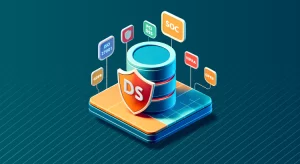
IT Security Policy
An IT security policy is a set of rules and guidelines that a company adopts to manage the protection of its information technology assets. This policy serves as a blueprint that directs the organization in safeguarding its data and technology infrastructure from a myriad of threats, including cyber-attacks, unauthorized access, and data breaches.

The Aim of an IT Security Policy
The primary goal of an IT security policy is to ensure the confidentiality, integrity, and availability of an organization’s data and IT resources. It aims to provide a clear framework for managing risks related to information security, establish responsibilities among employees, and lay down procedures for compliance with legal and regulatory requirements such as GDPR, SOX, PCI DSS, and others.
Why Do Companies Need an IT Security Policy?
In today’s digital landscape, the threats to data security are not only increasing in number but also sophistication. Companies need an IT security policy to protect their critical information assets, maintain customer trust, comply with regulatory requirements, and ensure the continuous operation of their business processes. A well-defined security policy is crucial for minimizing the risk of data breaches, which can lead to significant financial losses and damage to the company’s reputation.
Components of IT Security Policy
An effective IT security policy encompasses several key components, including the CIA triad:
- Confidentiality. Ensures that sensitive information is accessible only to authorized individuals.
- Integrity. Protects information from being altered by unauthorized parties, ensuring its accuracy and reliability.
- Availability. Guarantees that data and IT resources are available to authorized users when needed.
- Access Control. Manages who can access information and IT resources, under what circumstances, and what actions they are allowed to perform.
How to Write an IT Security Policy
Crafting an IT security policy begins with understanding the organization’s unique needs and risks. The policy should be comprehensive yet concise, clear, and accessible to all employees. Utilizing templates can provide a helpful starting point, offering a structured format that covers all essential aspects of security. Key steps include identifying sensitive data, assessing threats, defining security roles and responsibilities, and establishing procedures for incident response and recovery.
How DataSunrise Can Help at Maintaining an IT Security Policy
DataSunrise, a leader in database security solutions, can play a pivotal role in reinforcing your IT security policy. Our suite of tools includes data masking, activity monitoring, and database firewall capabilities that protect against unauthorized access and SQL injection attacks, among other threats.
DataSunrise’s solutions can ensure that the confidentiality, integrity, and availability of your data are maintained, aligning with the core components of your security policy. By integrating DataSunrise into your IT security framework, companies can benefit from enhanced protection for their data and databases, ensuring compliance with security policies and regulatory standards. To learn more, contact our team and schedule an online demo with a team of experts
Conclusion
An IT security policy is not just a set of guidelines but the foundation of a company’s data and database protection strategy. It delineates a clear path for safeguarding critical information assets against the evolving landscape of cyber threats. By incorporating comprehensive components, adhering to a structured policy creation process, and leveraging advanced solutions like DataSunrise, companies can significantly bolster their IT security posture. In doing so, they not only protect their valuable data but also secure their reputation and ensure the continuity of their business operations in the digital age.
